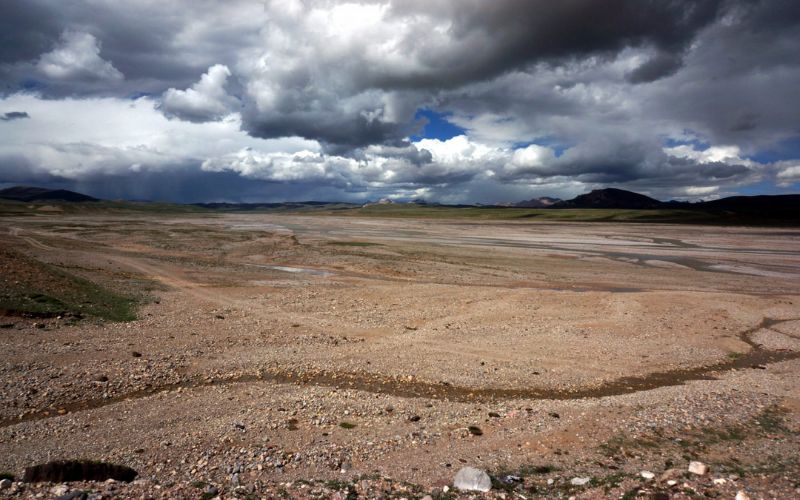
A seasonal dry-out in Sanjiangyuan region, the location of the headwaters of the Yellow River, the Yangtze, and the Lancang. (Photo by Yang Yong)
In a concerning case of greenwashing, Chinese media has been touting the conservation efforts in the Sanjiangyuan area of Tibet while concealing the grim reality of ongoing ecosystem challenges and the uncertain fate of relocated herders. Sanjiangyuan, often referred to as the "Source of three rivers," encompasses the headwaters of Asia's three mighty rivers – the Yangtze, Yellow, and Mekong – and plays a critical role in the region's ecological balance.
Sanjiangyuan is an area of the Tibetan Plateau which contains the headwaters of three great rivers of Asia: The Yellow River, the Yangtze River, and the Mekong River (Lancang River). The name “Sanjiangyuan” means “Source of three rivers.” The Yangtze River is 6,380 km long, the Yellow River is 5,464 km long, and the Mekong River is 4,350 km long. These rivers are three of the longest rivers in Asia and the world. These three rivers are important to the surrounding countries.
Despite the region's significance, the Sanjiangyuan Area faces mounting threats from infrastructure development, increased human activities, and the rapidly changing climate. Alarming reports reveal that 20% of mammal species with primary ranges in the Tibetan plateau are now listed as threatened by the IUCN, and wetlands have suffered substantial degradation.
The Sanjiangyuan Area covers the southern and eastern parts of Qinghai Province, China, and has an area of about 363,000 km2, 50.4% of Qinghai Province. It is the largest natural reserve in China and the most biodiversity concentrated in the world's high-altitude areas.
China’s strategy of frenetically building dams & reservoirs on transnational rivers will confront Asia with a more permanent barrier to long-term economic prosperity and water scarcity. China is building multiple dams to divert water into its own territory.
Tibet serves as the source of 10 major Asian river systems & provides water to about 2 billion people of Asia. China wants to grip over it by constructing dams, hydro-hegemony & surrounding it with so- called National Park against its downstream neighbors. Tibet is the largest repository of freshwater after he Arctic & Antarctica, and hence, is referred to as The Third Pole.
China took over Tibet which has eight major rivers, earning it the nickname "Water Hydrant" of the globe. China is damming them, diverting their waters, and causing massive environmental damage. Construction of large dams in Tibetan areas are having negative impacts on the environment.
"Today, China has turned this ecologically fragile plateau, which it invaded & occupied from 1950 to 1951, into the center of its mining & dam-building activities", stated Brahma Chellaney, Strategic thinker, author and commentator.
Sanjiangyuan National Park on the northern tip of Tibetan Plateau is roughly 14 times the size of Yellowstone National Park in United States. it serves as the foundation of the so called “National Parks” in Occupied Tibet.
“Clearly political, China’s mapping of national parks uses scientific assessments of species variety as justification for imposing national authority over Tibetan landscapes, particularly those that supply lowland China with water resources”, tweeted Gabriel Lafitte.
It required the reversal of the grazing rights of Tibetan nomads and their actual displacement from their ancestral grounds. Long term social, economic, and environmental effects will result from this choice.
The park enforces worked to evict Tibetan nomads from their ancestral dwellings inside the park’s boundaries when the area’s conservation status was strengthened. They started the resettlement procedure in 2005, and it is still going.
Park rangers are responsible for monitoring the removal of Tibetan nomads and their herds of yaks, sheep, and goats and ensuring that they dont return, hide animals up winding valleys, or rent the herd out to surviving neighbors. Sons may have to evict mothers.
In the name of biodiversity conservation, Chinese authorities goes on to depopulate numerous “protected” regions from their traditional defenders, the Tibetan. If CCP is so concerned about the biodiversity conservation in illegally Occupied Tibet as it claims, why are they ignoring the great biodiversity “Hotspot” of Tibet -Kham?
The economy and society of the Sanjiangyuan Area are underdeveloped. Traditional animal husbandry is still the main industry, which makes it harder to change the economic development model for the conservation goals. The territory is vast and sparsely populated, which makes it difficult to supervise violations of laws and regulations such as illegal mining or poaching.
The main population of this area is Tibetan, and the protection of local minority customs, history, and culture is also very important. Earlier, all the nomads of this region were forcibly shifted off the same grasslands to make way for mining exploitation. According to Chinese media, after three years’ endeavors, 28,000 herdsmen from 6,156 households relocated from mountains and valleys in the Sanjiangyuan region. This forced relocation of Tibetan nomads continues to this date.
Edited and collated by Team TRC